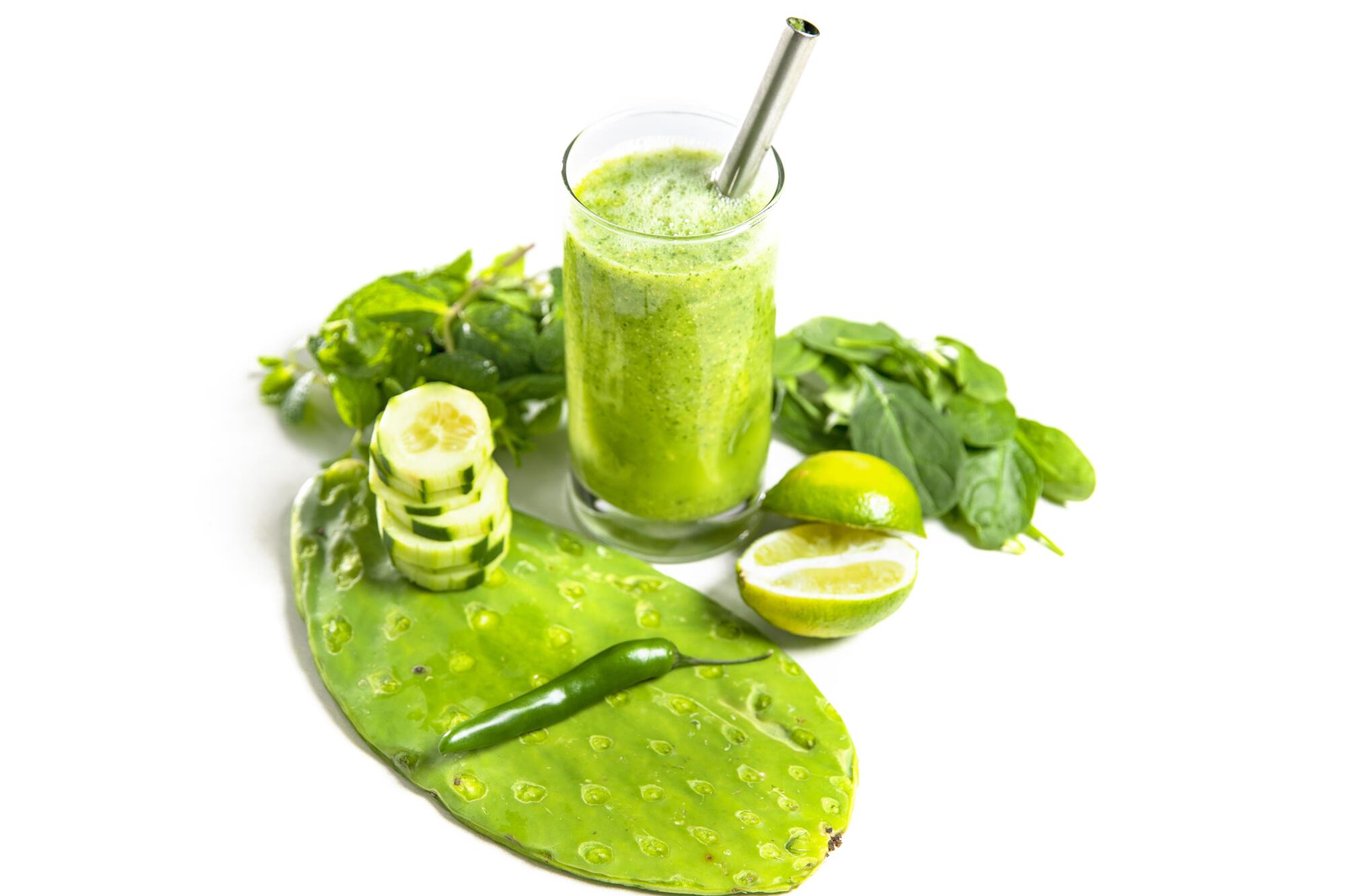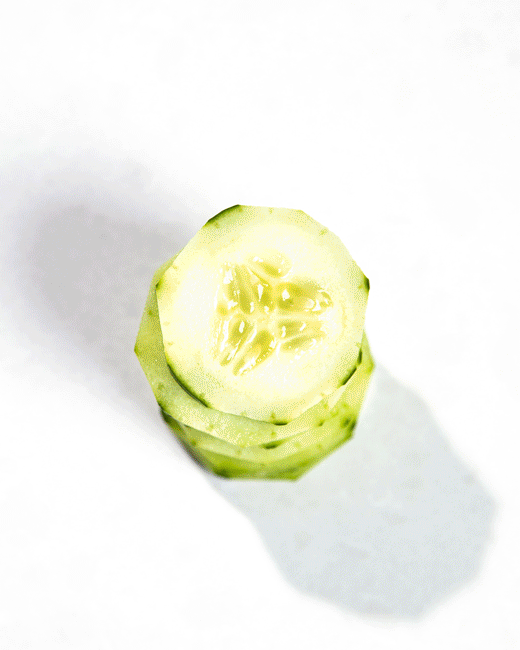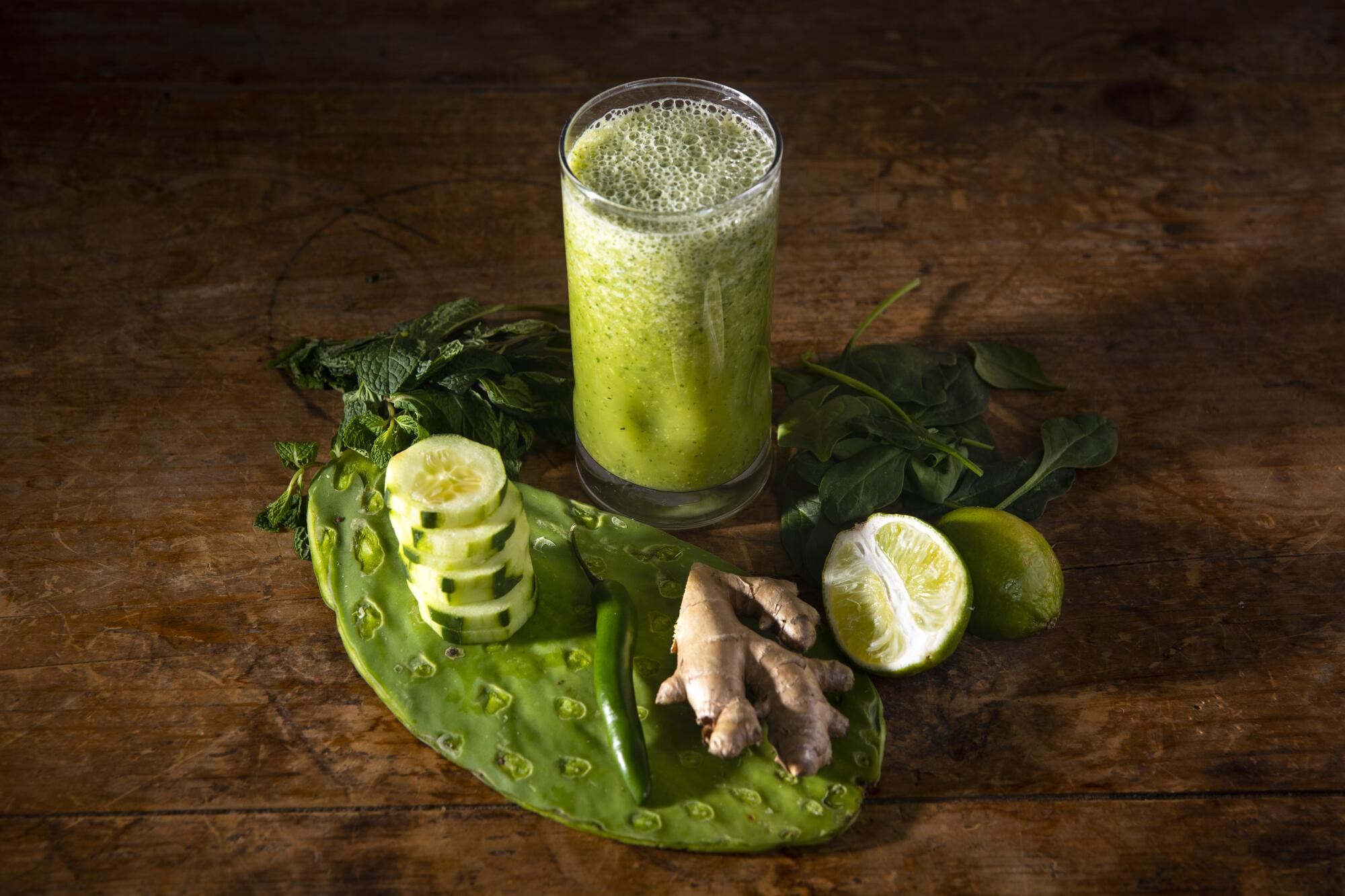
My jugo verde, a reminder of Mexico City, helps fight a cold or a hangover and contributes to my general well-being.
- Share via
When I came back from Mexico in 2016 and was living in Highland Park, one place on York Boulevard, amid a landscape of newer establishments, became a lifeline. I’d often pull up to busy Jugos Azteca, a couple doors down from El Huarache Azteca, and order a classic jugo verde, or Mexican green juice.
With this simple, blended concoction of orange juice and a selection of green fruits or veggies — traditionally the base must include celery, parsley and cactus paddle — I could immediately be transported to my former home.
In Mexico City, where I worked as a journalist between 2007 and 2015, jugo verde is an abundant presence. I became accustomed to constant access to street corner stalls that sell fresh-squeezed juices — mostly straight orange juice, made with Mexico’s characteristically fat and sweet domestic oranges. These stalls are busiest in the mornings, when workaday chilangos are rushing to grab a to-go cup of fresh OJ before heading to the office. I learned that such stalls also make killer mixed blended juices like the vampiro (“vampire”) — a blood-red mixture of beet, orange and carrot — or the tangy, refreshing verde.
The shock of the antioxidant-rich ingredients would hit my brain like a mallet. I’d marvel, agog, at the dexterity of my corner juicers, usually an older lady or man accompanied by a young apprentice, picking up practice. The jugo verde not only helped relieve a hangover or fight a cold but also seemed to help me achieve balance in my digestive system, combat inflammation and generally keep me alert and peppy until lunchtime.
American-made cold green juices seem somehow joyless, like green juice homework.
After a while, I noticed that vendors offered variations on the basic recipe. Some added loads of sugar (not ideal), or cucumber or chunks of yellow guava or pineapple. Others, I noticed, tossed in fresh mint, which offered my first aha! moment once I began attempting to make the jugo verde at home. Mint in a green juice, I discovered, increased the flavor quotient considerably.
With some practice, I developed a personalized take on the Mexican jugo verde that emphasizes spice and tartness: Using market-fresh ingredients, I expanded the base to include pineapple, green apple and fresh Mexican mint. Freshness was key, and this was easy to practice since I lived literally 10 paces from the entrance to a traditional market in the Colonia Juárez neighborhood (a convenience that may be one of the purest of luxuries in any civilized setting). In Los Angeles, finding that most chain or Latin supermarkets carried my ingredients, I refined the recipe further.

The final evolution of my jugo verde came at the onset of the COVID-19 pandemic and the lockdowns. As the rainy months of spring 2020 slogged on, one morning I doubled down on spice. I started adding a bit of green serrano chile, then a few chunks of ginger, and — wow. The power of the ginger and chiles made my nose sweat — in a good way. I came to believe my green juice intake helped keep my defenses strong and my digestive system happy when I’d otherwise be stress-eating.
Now, my green juice owes nothing to the cold-pressed green juice trend that took off here in the States in recent years. In fact, my gut tells me the reverse might be true. American-made cold green juices — the kind sold at those extremely out-of-reach juice shops and markets — tend to go heavy on veggies that one could describe as savory, such as kale or broccoli. To me, such products seem somehow joyless, like green juice homework. And, as is characteristic of such trends, U.S. cold-pressed green juices have suffered a backlash.
Yet their appeal endures. In “The Green Smoothie Bible,” Kristine Miles writes: “People who have introduced green smoothies into their diets report many health benefits such as clearer skin, improved digestion, weight loss, and better mood.”
I concur, with the only caveat that a jugo verde contains lots of natural sugars, so be mindful of this if you watch your sugar intake. Even so, in the last two years, my jugo verde has transformed into a full-scale, hot as hell, green as grass beauty that I swear has helped me stay healthy and forward-focused in the day to day. Now, with the new year rolling in and resolutions aplenty, is a perfect time to join me.
The preparation process is labor-intensive: Cutting, shaving, trimming and skinning the ingredients is messy and produces a lot of compost waste. In order to avoid missing a day, I might prepare my ingredients the night before, and I may end up, if I’m feeling particularly lazy, storing the chopped and sliced components in the blender container directly in my fridge, holding back the OJ until morning, when I can easily hit “blend” upon rising.
About twice a week, I run a blender’s worth of my jugo verde mix and store up to three glasses of it, covered with aluminum foil or plastic wrap. This allows me to make one large batch that lasts at least three or four days. Upon settling, the blended cactus will make the liquid separate to the bottom from the bits and mass of fruits on top, which become gooey. Don’t worry: You can remix a stored glass of the jugo verde by simply pouring it between two large glasses, or giving it a fresh shot of OJ and a quick whisk with a spoon or fork. It keeps just fine.
I’ve also learned to be flexible and creative. Depending on what’s in season or available at my Latin supermarket or neighborhood farmers market, I’ll add chunks of other things — just as long as the fruit involved is green or yellow, and tart or sweet, and not a lettuce. A bit of pear? A sprig of dill? One skinned and halved kiwi? Sure. The primary goal here is that my sour taste receptors really spark up the moment this spicy jugo verde comes to mind.

Daniel’s Spicy Jugo Verde (Mexican Green Juice):
Time: 10-15 minutes prep chopping and cutting. Less than 1 minute blending. Makes 4-5 servings.
Note: This is a sour, pucker-intensive, ginger-hot juice. If you dislike the intensity of its flavor, you can drop the serrano chile and the ginger. If in season or handy, you can also add a small bunch of parsley or dill with no stems; a yellow guava or guayaba (strain the juice after to remove the seeds); a white, yellow or green pear; or even green prickly pear fruit. Avoid herbs like rosemary or cilantro, lettuces or anything else that isn’t green or yellow.
Ingredients:
3 cups fresh orange juice, or tangerine or grapefruit juice
1½ cups thinly sliced, cleaned Mexican nopal (cactus; about 3/4 paddle)
1 cup lightly packed fresh mint leaves (avoid purple leaves and any stems)
1 cup lightly packed baby spinach leaves
¾ cup roughly chopped celery
¾ cup thinly sliced cucumber (remove half the peel in strips before slicing)
¾ cup roughly chopped pineapple (avoid any brown parts)
¾ of a green apple
½ cup roughly chopped, peeled fresh ginger
¾ of a single serrano chile (remove seeds for milder juice)
Juice of 1 or 2 fresh squeezed limes, or a splash of lime juice, limeade or lemon juice
ice (optional)
1. In a high-powered blender, combine the orange juice, nopal, mint, spinach, celery, cucumber, pineapple, green apple, ginger and chile. Add the lime juice to taste and a handful of ice, if using.
2. Blend the ingredients on high until smooth, about 30 seconds. Pour into serving glasses or divide among glass jars, cover and refrigerate for up to four days.
More to Read
Eat your way across L.A.
Get our weekly Tasting Notes newsletter for reviews, news and more.
You may occasionally receive promotional content from the Los Angeles Times.









